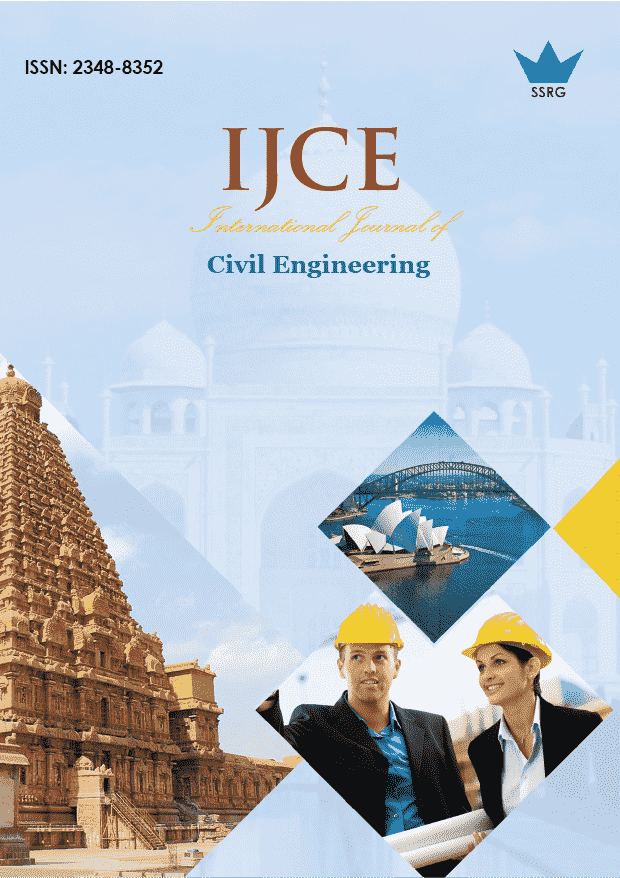Predicting Concrete Strength Using Regression-Based Machine Learning Techniques

| International Journal of Civil Engineering |
| © 2025 by SSRG - IJCE Journal |
| Volume 12 Issue 10 |
| Year of Publication : 2025 |
| Authors : S.Selvi, S.E. Murthy, Balaji Govindan, D. Leela Rani, Mutyala Suresh |
How to Cite?
S.Selvi, S.E. Murthy, Balaji Govindan, D. Leela Rani, Mutyala Suresh, "Predicting Concrete Strength Using Regression-Based Machine Learning Techniques," SSRG International Journal of Civil Engineering, vol. 12, no. 10, pp. 139-146, 2025. Crossref, https://doi.org/10.14445/23488352/IJCE-V12I10P111
Abstract:
Accurate prediction of concrete Compressive Strength (CS) is crucial for optimizing mix design and ensuring structural reliability. The prediction of concrete Strength remains challenging owing to the complex relationship between the components of the concrete mixture. Although several traditional methods are available, they are mostly experiment-based and are expensive and often inaccurate. This research employs Machine Learning (ML) approaches to estimate the Compressive Strength of concrete (CS) and to analyse how the input parameters influence the output response. Five tree-based regression algorithms, such as Random Forest and other boosting variants, were assessed to determine their predictive capability. The dataset contains 1030 samples with features such as water, fly ash, cement, age, coarse and fine aggregates, superplasticizer, and slag. Serve as inputs for developing the ML models. The model's accuracy is evaluated by metrics such as R², RMSE, and MAE. Based on the evaluation metrics, CatBoost is the best-performing model for predicting concrete compression strength. SHAP analysis further revealed that the age of the concrete and the amount of cement used are the most influential factors.
Keywords:
Artificial Intelligence, Catboost, Compressive Strength, Machine Learning, Shap.
References:
[1] M. Ahmadi, H. Naderpour, and A. Kheyroddin, “Utilization of Artificial Neural Networks to Prediction of the Capacity of CCFT Short Columns Subject to Short Term Axial Load,” Archives of Civil and Mechanical Engineering, vol. 14, no. 3, pp. 510-517, 2014.
[CrossRef] [Google Scholar] [Publisher Link]
[2] Faeze Khademi et al., “Predicting Strength of Recycled Aggregate Concrete Using Artificial Neural Network, Adaptive Neuro-Fuzzy Inference System and Multiple Linear Regression,” International Journal of Sustainable Built Environment, vol. 5, no. 2, pp. 355-369, 2016.
[CrossRef] [Google Scholar] [Publisher Link]
[3] Zhibin He et al., “A Comparative Study of Artificial Neural Network, Adaptive Neuro Fuzzy Inference System and Support Vector Machine for Forecasting River Flow in the Semiarid Mountain Region,” Journal of Hydrology, vol. 509, pp. 379-386, 2014.
[CrossRef] [Google Scholar] [Publisher Link]
[4] Anh-Duc Pham, Nhat-Duc Hoang, and Quang-Trung Nguyen, “Predicting Compressive Strength of High-Performance Concrete Using Metaheuristic-Optimized Least Squares Support Vector Regression,” Journal of Computing in Civil Engineering, vol. 30, no. 3, 2016.
[CrossRef] [Google Scholar] [Publisher Link]
[5] Doddy Prayogo, Foek Tjong Wong, and Daniel Tjandra, “Prediction of High-Performance Concrete Strength Using a Hybrid Artificial Intelligence Approach,” MATEC Web of Conferences, vol. 203, pp. 1-12, 2018.
[CrossRef] [Google Scholar] [Publisher Link]
[6] Jui-Sheng Chou et al., “Machine Learning in Concrete Strength Simulations: Multi-Nation Data Analytics,” Construction and Building Materials, vol. 73, pp. 771-780, 2014.
[CrossRef] [Google Scholar] [Publisher Link]
[7] Aman Kumar et al., “Prediction of FRCM–Concrete Bond Strength with Machine Learning Approach,” Sustainability, vol. 14, no. 2, pp. 1-25, 2022.
[CrossRef] [Google Scholar] [Publisher Link]
[8] Shi-Zhi Chen et al., “Ensemble Learning Based Approach for FRP-Concrete Bond Strength Prediction,” Construction and Building Materials, vol. 302, 2021.
[CrossRef] [Google Scholar] [Publisher Link]
[9] Wang Zeyu et al., “Random Forest Based Hourly Building Energy Prediction,” Energy and Buildings, vol. 171, pp. 11-25, 2018.
[CrossRef] [Google Scholar] [Publisher Link]
[10] Seyyed Mohammad Mousavi et al., “A New Predictive Model for Compressive Strength of HPC Using Gene Expression Programming,” Advances in Engineering Software, vol. 45, no. 1, pp. 105-114, 2012.
[CrossRef] [Google Scholar] [Publisher Link]
[11] Jiandong Huang et al., “Predicting the Compressive Strength of the Cement-Fly Ash–Slag Ternary Concrete Using the Firefly Algorithm (FA) and Random Forest (RF) Hybrid Machine-Learning Method,” Materials, vol. 15, no. 12, pp. 1-15, 2022.
[CrossRef] [Google Scholar] [Publisher Link]
[12] Hongwei Song et al., “Predicting the Compressive Strength of Concrete with Fly Ash Admixture Using Machine Learning Algorithms,” Construction and Building Materials, vol. 308, pp. 1-15, 2021.
[CrossRef] [Google Scholar] [Publisher Link]
[13] Furqan Farooq et al., “A Comparative Study for the Prediction of the Compressive Strength of Self-Compacting Concrete Modified with Fly Ash,” Materials, vol. 14, no. 17, pp. 1-27, 2021.
[CrossRef] [Google Scholar] [Publisher Link]
[14] Jesús de-Prado-Gil et al., “To Predict the Compressive Strength of Self Compacting Concrete with Recycled Aggregates Utilizing Ensemble Machine Learning Models,” Case Studies in Construction Materials, vol. 16, pp. 1-17, 2022.
[CrossRef] [Google Scholar] [Publisher Link]
[15] Tianyu Xie et al., “A Unified Model for Predicting the Compressive Strength of Recycled Aggregate Concrete Containing Supplementary Cementitious Materials,” Journal of Cleaner Production, vol. 251, 2020.
[CrossRef] [Google Scholar] [Publisher Link]
[16] Kabiru O. Akande et al., “Performance Comparison of SVM and ANN in Predicting Compressive Strength of Concrete,” IOSR Journal of Computer Engineering, vol. 16, no. 5, pp. 88-94, 2014.
[CrossRef] [Google Scholar] [Publisher Link]
[17] Ayaz Ahmad et al., “Comparative Study of Supervised Machine Learning Algorithms for Predicting the Compressive Strength of Concrete at High Temperature,” Materials, vol. 14, no. 15, pp. 1-19, 2021.
[CrossRef] [Google Scholar] [Publisher Link]
[18] Wenbin Lan et al., “Accurate Compressive Strength Prediction Using Machine Learning Algorithms and Optimization Techniques,” Journal of Engineering Applied Science, vol. 71, pp. 1-20, 2024.
[CrossRef] [Google Scholar] [Publisher Link]
[19] De-Cheng Feng et al., “Machine Learning-Based Compressive Strength Prediction for Concrete: An Adaptive Boosting Approach,” Construction and Building Materials, vol. 230, 2020.
[CrossRef] [Google Scholar] [Publisher Link]
[20] Vivian W.Y. Tam et al., “A Prediction Model for Compressive Strength of CO2 Concrete Using Regression Analysis and Artificial Neural Networks,” Construction and Building Materials, vol. 324, 2022.
[CrossRef] [Google Scholar] [Publisher Link]
[21] Zaher Mundher Yaseen et al., “Predicting Compressive Strength of Lightweight Foamed Concrete Using Extreme Learning Machine Model,” Advances in Engineering Software, vol. 115, pp. 112-125, 2018.
[CrossRef] [Google Scholar] [Publisher Link]
[22] Ayaz Ahmad et al., “Application of Novel Machine Learning Techniques for Predicting the Surface Chloride Concentration in Concrete Containing Waste Material,” Materials, vol. 14, no. 9, pp. 1-18, 2021.
[CrossRef] [Google Scholar] [Publisher Link]
[23] Ayaz Ahmad et al., “Compressive Strength Prediction of Fly Ash-Based Geopolymer Concrete via Advanced Machine Learning Techniques,” Case Studies in Construction Materials, vol. 16, pp. 1-16, 2022.
[CrossRef] [Google Scholar] [Publisher Link]
[24] Zhiyuan Li et al., “High Temporal Resolution Prediction of Street-Level PM2.5 and NOx Concentrations Using Machine Learning Approach,” Journal of Cleaner Production, vol. 268, 2020.
[CrossRef] [Google Scholar] [Publisher Link]
[25] Mostafa Jalal, and Hamid Jalal, “RETRACTED: Behavior Assessment, Regression Analysis and Support Vector Machine (SVM) Modeling of Waste Tire Rubberized Concrete,” Journal of Cleaner Production, vol. 273, pp. 1-15, 2020.
[CrossRef] [Google Scholar] [Publisher Link]
[26] Fangming Deng et al., “Compressive Strength Prediction of Recycled Concrete Based on Deep Learning,” Construction and Building Materials, vol. 175, pp. 562-569, 2018.
[CrossRef] [Google Scholar] [Publisher Link]
[27] S. Selvi et al., “Enhancing Short-Term PV Power Forecasting Using Deep Learning Models: A Comparative Study of DNN and CNN Approaches,” SSRG International Journal of Electrical and Electronics Engineering, vol. 11, no. 8, pp. 73-80, 2024. [CrossRef] [Google Scholar] [Publisher Link]

 10.14445/23488352/IJCE-V12I10P111
10.14445/23488352/IJCE-V12I10P111